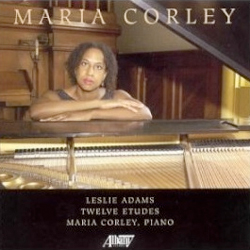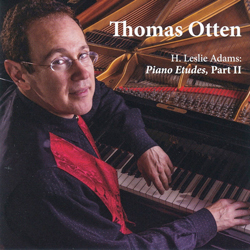by Daniel Hathaway

Separately, Adams has written that one of his Oberlin composition teachers told him, “Leslie, you have a unique gift for melody. Stick with it.” The composer adds, “I took his great advice and have pursued a ‘bel canto path’ throughout my career.’
That career has been a long one — Adams is now an octogenarian — and it has recently been crowned by the world premiere performances of his complete Etudes at the University of North Carolina, Chapel Hill. Two recitals by pianists Maria Corley and Thomas Otten provided the grand finale to the UNC music department’s Etude Festival, held from October 26-November 2, 2014.
Corley had previously recorded the first dozen Etudes for Albany Records. Otten followed that with volume two, recorded at Hill Hall Auditorium at UNC in December, 2013 and January 2014 (also on the Albany label). Though we have Otten’s CD in hand, this article is based on a DVD we received of the live performances last November 1 and 2.
In a Broad Street Review blog entry, Jamaican-born, Canadian pianist Maria Thompson Corley, who did her undergraduate studies at the University of Alberta and won her master’s and doctoral degrees from Juilliard, notes that the Etudes “explore all registers of the piano. The writing is often thick, with multiple climactic moments and, as one would expect with etudes, a wide variety of technical demands…There is certainly dissonance, but Leslie writes from the heart. Of course, you don’t have to be neo-romantic with touches of jazz and popular music to write from the heart. But in Leslie’s case, that’s how things turned out.”
UNC music professor Thomas Otten first met Adams’s Etudes at a festival in Chapel Hill in 2012. He has written, “As one unfamiliar with Leslie’s music, I found myself in for a real treat! His style, though classically rooted, incorporates strong elements of jazz and popular music, giving it a crossover vibe that’s most engaging … invoking a sound world where Rachmaninoff meets Burt Bacharach, so to speak” (Africlassical blog).
Those comments from the two performers go a long way toward explaining the general attractiveness of Leslie Adams’ music and the effect it has had on them as pianists. For the world premiere last November, both Corley and Otten took the trouble to memorize their recitals, a detail that makes their fine and nuanced performances — as seen on the DVD — even more committed.
In addition to the neo-romantic, jazz and popular music elements the performers have cited, the twenty-six etudes are at times reminiscent of Chopin, Debussy and Schumann, to name just a few pianists’ styles that seem deeply ingrained in the composer’s consciousness, though those references are fleeting — vague references rather than borrowings. The piano writing is expert and varied, the formats ranging from nocturnes to fantasias, toccatas and ballads.
Adams noted that his last three Etudes are “settings of pop songs with lyrics I wrote many years ago — thus, they are ‘songs without words.’” And lovely settings of lovely songs they are. As Corley has written, “After a journey of big chords, glimmering scales, and rapid arpeggiation, the last etude is reflective. It’s a satisfying choice, a built-in encore.”
Though these pieces break little new ground musically, they’re wonderfully listenable and get under your skin in completely enjoyable ways. Because they present different levels of difficulty (and only one is set in such an alien key as D-sharp minor), Adams’ Etudes should attract pianists of all stages. Perhaps some performers (or pairs of pianists) will even want to take the complete set on as a project, as Corley and Otten so successfully have done.
Published on ClevelandClassical.com January 15, 2015.
Click here for a printable copy of this article





